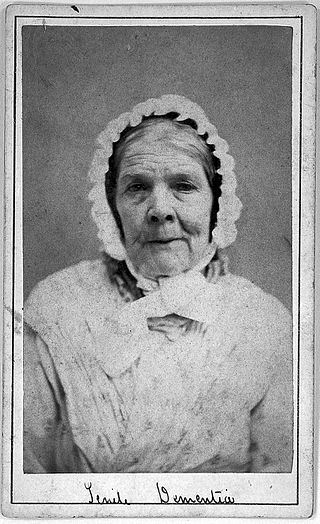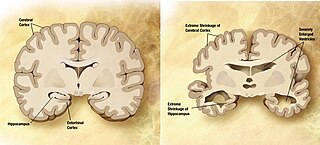Related Research Articles

Dementia is a syndrome associated with many neurodegenerative diseases, characterized by a general decline in cognitive abilities that affects a person's ability to perform everyday activities. This typically involves problems with memory, thinking, behavior, and motor control. Aside from memory impairment and a disruption in thought patterns, the most common symptoms of dementia include emotional problems, difficulties with language, and decreased motivation. The symptoms may be described as occurring in a continuum over several stages. Dementia ultimately has a significant effect on the individual, their caregivers, and their social relationships in general. A diagnosis of dementia requires the observation of a change from a person's usual mental functioning and a greater cognitive decline than might be caused by the normal aging process.
Aging of the brain is a process of transformation of the brain in older age, including changes all individuals experience and those of illness. Usually this refers to humans.
Cognitive disorders (CDs), also known as neurocognitive disorders (NCDs), are a category of mental health disorders that primarily affect cognitive abilities including learning, memory, perception, and problem-solving. Neurocognitive disorders include delirium, mild neurocognitive disorders, and major neurocognitive disorder. They are defined by deficits in cognitive ability that are acquired, typically represent decline, and may have an underlying brain pathology. The DSM-5 defines six key domains of cognitive function: executive function, learning and memory, perceptual-motor function, language, complex attention, and social cognition.
Cerebral atrophy is a common feature of many of the diseases that affect the brain. Atrophy of any tissue means a decrement in the size of the cell, which can be due to progressive loss of cytoplasmic proteins. In brain tissue, atrophy describes a loss of neurons and the connections between them. Brain atrophy can be classified into two main categories: generalized and focal atrophy. Generalized atrophy occurs across the entire brain whereas focal atrophy affects cells in a specific location. If the cerebral hemispheres are affected, conscious thought and voluntary processes may be impaired.

Amyloid plaques are extracellular deposits of the amyloid beta (Aβ) protein mainly in the grey matter of the brain. Degenerative neuronal elements and an abundance of microglia and astrocytes can be associated with amyloid plaques. Some plaques occur in the brain as a result of aging, but large numbers of plaques and neurofibrillary tangles are characteristic features of Alzheimer's disease. The plaques are highly variable in shape and size; in tissue sections immunostained for Aβ, they comprise a log-normal size distribution curve, with an average plaque area of 400-450 square micrometers (μm2). The smallest plaques, which often consist of diffuse deposits of Aβ, are particularly numerous. Plaques form when Aβ misfolds and aggregates into oligomers and longer polymers, the latter of which are characteristic of amyloid.

Neurofibrillary tangles (NFTs) are intracellular aggregates of hyperphosphorylated tau protein that are most commonly known as a primary biomarker of Alzheimer's disease. Their presence is also found in numerous other diseases known as tauopathies. Little is known about their exact relationship to the different pathologies.

School Sisters of Notre Dame is a worldwide religious institute of Roman Catholic sisters founded in Bavaria in 1833 and devoted to primary, secondary, and post-secondary education. Their life in mission centers on prayer, community life and ministry. They serve as teachers, lawyers, accountants, nurses, administrators, therapists, social workers, pastoral ministers, social justice advocates and more.

Age-related memory loss, sometimes described as "normal aging", is qualitatively different from memory loss associated with types of dementia such as Alzheimer's disease, and is believed to have a different brain mechanism.
Cognitive reserve is the mind's and brain's resistance to damage of the brain. The mind's resilience is evaluated behaviorally, whereas the neuropathological damage is evaluated histologically, although damage may be estimated using blood-based markers and imaging methods. There are two models that can be used when exploring the concept of "reserve": brain reserve and cognitive reserve. These terms, albeit often used interchangeably in the literature, provide a useful way of discussing the models. Using a computer analogy, brain reserve can be seen as hardware and cognitive reserve as software. All these factors are currently believed to contribute to global reserve. Cognitive reserve is commonly used to refer to both brain and cognitive reserves in the literature.
The Nun Study of Aging and Alzheimer's Disease is a continuing longitudinal study, begun in 1986, to examine the onset of Alzheimer's disease. David Snowdon, an Epidemiologist and the founding Nun Study investigator, started the Nun Study at the University of Minnesota, later transferring the study to the University of Kentucky in 1990. In 2008, with Snowdon's retirement, the study returned to the University of Minnesota. The Nun Study was very briefly moved from the University of Minnesota to Northwestern University in 2021 under the directorship of Dr. Margaret Flanagan. The Nun Study is currently housed at the University of Texas Health San Antonio in the Bigg's Institute for Alzheimer's and Neurodegenerative diseases under the continued directorship of Neuropathologist, Dr. Margaret Flanagan.
Lipohyalinosis is a cerebral small vessel disease affecting the small arteries, arterioles or capillaries in the brain. Originally defined by C. Miller Fisher as 'segmental arteriolar wall disorganisation', it is characterized by vessel wall thickening and a resultant reduction in luminal diameter. Fisher considered this small vessel disease to be the result of hypertension, induced in the acute stage by fibrinoid necrosis that would lead to occlusion and hence lacunar stroke. However, recent evidence suggests that endothelial dysfunction as a result of inflammation is a more likely cause for it. This may occur subsequent to blood–brain barrier failure, and lead to extravasation of serum components into the brain that are potentially toxic. Lacunar infarction could thus occur in this way, and the narrowing – the hallmark feature of lipohyalinosis – may merely be a feature of the swelling occurring around it that squeezes on the structure.

Alzheimer's disease (AD) is a neurodegenerative disease that usually starts slowly and progressively worsens, and is the cause of 60–70% of cases of dementia. The most common early symptom is difficulty in remembering recent events. As the disease advances, symptoms can include problems with language, disorientation, mood swings, loss of motivation, self-neglect, and behavioral issues. As a person's condition declines, they often withdraw from family and society. Gradually, bodily functions are lost, ultimately leading to death. Although the speed of progression can vary, the average life expectancy following diagnosis is three to twelve years.

Type 3 diabetes is a proposed pathological linkage between Alzheimer's disease and certain features of type 1 and type 2 diabetes. Specifically, the term refers to a set of common biochemical and metabolic features seen in the brain in Alzheimer's disease, and in other tissues in diabetes; it may thus be considered a "brain-specific type of diabetes." It was recognized at least as early as 2005 that some features of brain function in Alzheimer's disease mimic those that underlie diabetes. However, the concept of type 3 diabetes is controversial, and as of 2021 it was not an officially recognized diagnosis.
Clinical neuroscience is a branch of neuroscience that focuses on the scientific study of fundamental mechanisms that underlie diseases and disorders of the brain and central nervous system. It seeks to develop new ways of conceptualizing and diagnosing such disorders and ultimately of developing novel treatments.
Florbetaben, sold under the brand name Neuraceq, is a diagnostic radiotracer developed for routine clinical application to visualize β-amyloid plaques in the brain. It is a fluorine-18 (18F)-labeled stilbene derivative.

LATE is a term that describes a prevalent condition with impaired memory and thinking in advanced age, often culminating in the dementia clinical syndrome. In other words, the symptoms of LATE are similar to those of Alzheimer's disease.
Nicole Schupf is an American epidemiologist and neuroscientist who is Professor of Epidemiology in Neurology, Psychiatry, the Gertrude H. Sergievsky Center, and the Taub Institute for Research on Alzheimer's Disease and the Aging Brain, Columbia University Faculty of Medicine. She studies aging and Alzheimer's disease in individuals with Down syndrome.
The Women's Healthy Ageing Project (WHAP) is the longest ongoing medical research project examining the health of Australian women. Its landmark studies concern women's heart and brain health, a long-neglected area of specialised research.
Martha Clare Morris was an American nutritional epidemiologist who studied the link between diet and Alzheimer's disease. She led a team of researchers at the Rush University Medical Center to develop the MIND diet.
David A Bennett is a neurologist, Director of the Rush Alzheimer's Disease Center (RADC), and the Robert C Borwell Professor of Neurology at Rush University Medical Center.Bennett is also Visiting Professor, Instituto de Assistencia Medica ao Servidor Publico Estadual (IAMSPE), São Paulo, Brazil.
References
- ↑ "Friday the 13th woes at the New Yorker". NY Post. June 6, 1999. Retrieved 29 June 2018.
- ↑ Reimer, Susan (August 12, 2012). "Sister Genevieve Kunkel, longtime nun and educator". Baltimore Sun. Retrieved 29 June 2018.
- ↑ Belluck, Pam (May 7, 2001), Nuns Offer Clues to Alzheimer's and Aging Archived 2016-03-04 at the Wayback Machine , New York Times (republished by University of South Florida)
- ↑ Dunkel, Tom (18 June 2006). "Offering an education in aging". Baltimore Sun. Retrieved 24 June 2023.
- ↑ Snowdon, David A. (2002). Aging with Grace: What the Nun Study Teaches Us About Leading Longer, Healthier, and More Meaningful Lives. New York, New York: Bantam Books. ISBN 0-553-38092-3.